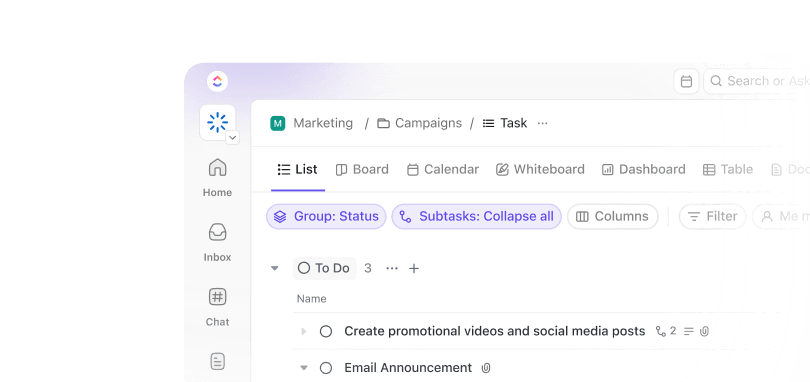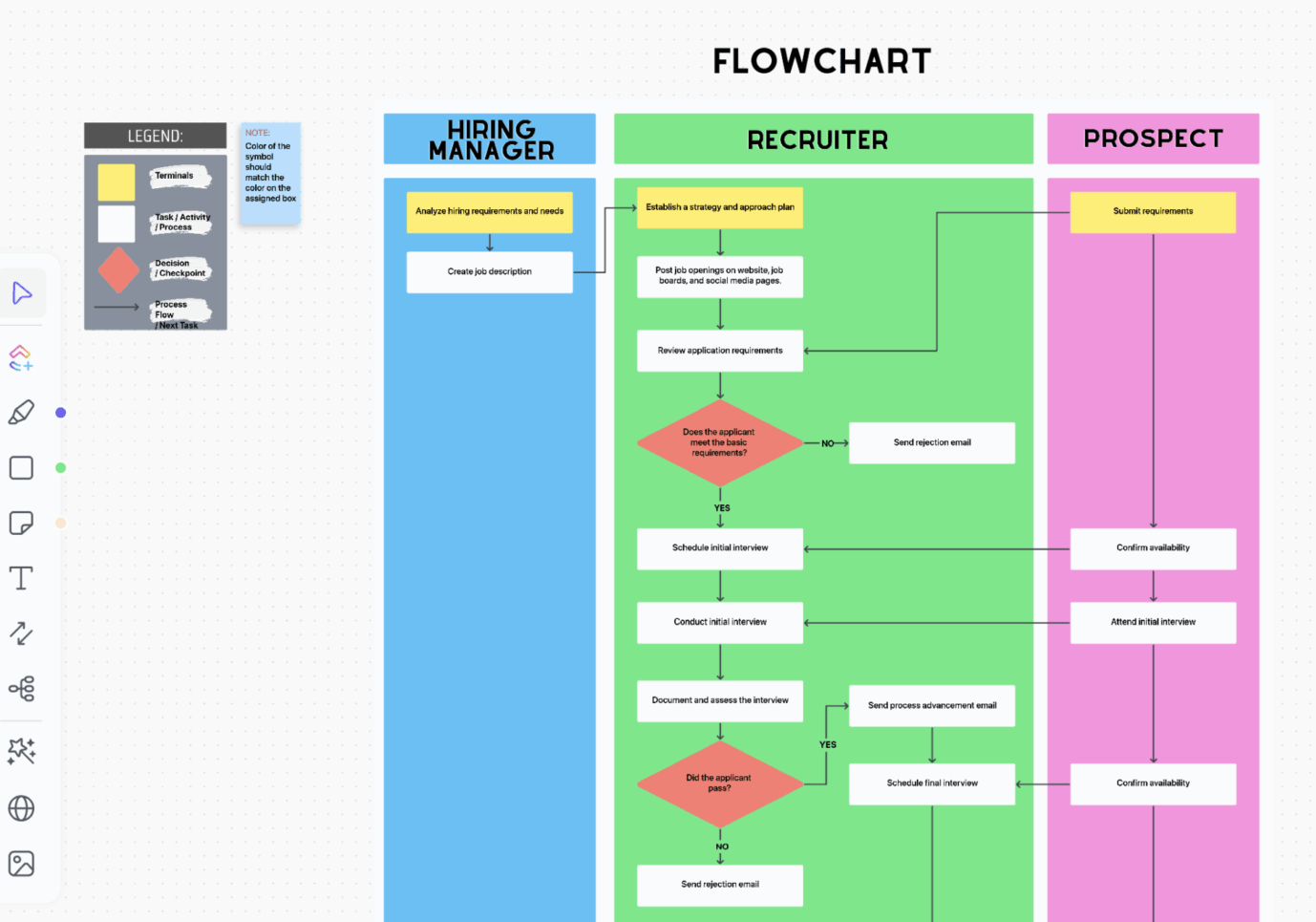Adding new tools shouldn’t feel like stacking Jenga blocks. One wrong move shouldn’t collapse your workflows, but as your business grows, that’s often what it feels like. What began as a smooth workflow management process quickly became a fragile tower of disconnected apps, manual processes, and scattered communication.
Instead of boosting efficiency, tools like Slack, Google Workspace, or your ERP start creating more friction than flow.
That’s where workflow orchestration systems can bring order to the chaos.
It connects people, automation, and systems, transforming scattered tasks into streamlined, scalable workflows—fewer headaches. Smarter work.
In this article, we’ll break down how workflow orchestration can streamline operations, boost efficiency, add real business value, and how to implement it effectively using modern tools like . 🚀
How to Streamline Workflow Orchestration for Greater Efficiency
What Is Workflow Orchestration?
Workflow orchestration is the automated coordination and management of various tasks, systems, and data to create a smooth, end-to-end process.
It ensures that each task happens at the right time, with the right data. If something goes wrong, the system detects and corrects the issue before it disrupts the entire process.
Let’s look at it through an example. When a new customer signs up for your service, you need to:
- Create their account in the CRM
- Add them to the email marketing platform
- Send a welcome email
- Start an onboarding sequence
- Generate a support ticket for account setup
- Notify the customer success team
- Schedule an initial consultation
Workflow orchestration manages this entire sequence. It kicks off a smooth chain of actions that gets things done from start to finish, making managing complex workflows feel much easier.
With workflow management software, enterprises can coordinate multiple workflows effectively and improve efficiency.
Workflow orchestration vs. workflow automation
While workflow orchestration and workflow automation are often used interchangeably, they represent different levels of process management:
Workflow automation refers to automating individual tasks within a process. These tasks can run without human intervention.
📌 Example: Automatically sending a confirmation email when a form is submitted. Setting up an automation in to change a task status when a due date passes.
Workflow orchestration focuses on coordinating and managing multiple automated tasks and potentially human steps across different systems to achieve a larger, end-to-end business process. It’s about the “big picture” flow.
📌 Example: Coordinating the entire employee onboarding process described earlier, ensuring the automated email task only triggers after the automated account provisioning task is complete, even if they happen in different systems.
Think of process automation as setting up a script to back up your files. It’s efficient but does just one thing. Orchestration is more extensive. It cohesively manages and coordinates multiple systems to back up, sort, and archive your files.
🧠 Fun Fact: The Ford Motor Company coined the term “automation” in the 1940s to refer to the automatic handling of parts in metalworking processes. The term “orchestration” comes from music, where a conductor coordinates instruments, just like workflow orchestrators coordinate tasks across multiple systems!
Let’s break it down with a quick table:
| Feature | Workflow automation | Workflow orchestration |
| Focus | Automates individual tasks | Coordinates multiple automated tasks |
| Score | One task at a time | End-to-end process management |
| Function | Improves efficiency and task accuracy | Optimizes entire business processes |
| Level of complexity | Lower | Higher, with various steps, dependencies, and integrations |
| Software | Uses workflow automation software | Part of a larger digital transformation strategy |
Key Benefits of Workflow Orchestration
Implementing orchestration delivers significant advantages for improved workflow efficiency:
Increased efficiency and productivity
Automating tasks and optimizing workflows reduces manual effort. It speeds up multiple processes simultaneously and eliminates operational issues.
Reduced errors and improved compliance
Humans excel at many things, but repetitive tasks often lead to mistakes. Orchestration improves accuracy and consistency and reduces the need for rework.
It ensures compliance by aligning processes with industry regulations, security standards, and company policies, reducing the risk of human errors or violations.
Better scalability and adaptability
Workflow orchestration is adaptable. You can quickly scale processes to meet new demands without overhauling your systems, which is especially helpful if your business is fast-growing.
Cost reduction and resource optimization
Routine manual tasks, when handled manually, take up valuable time and money. Automating these tasks allows your team to focus on more impactful work while cutting labor costs.
Improved employee and customer satisfaction
Smoother internal processes reduce employee frustration. Faster, more reliable service delivery (like quicker onboarding or order fulfillment) enhances customer satisfaction.
Better visibility and control
Orchestrating workflows provides a clear, centralized view of your business operations. You can track real-time progress, make informed decisions, and improve your daily operations management.
How to Implement Workflow Orchestration?
Implementing workflow orchestration can feel overwhelming, especially if you’re used to manual processes or relying on different automation tools for different processes. However, approaching it systematically can make the process much easier.
1. Identify and map processes
Start by identifying complex, high-value, or error-prone processes that span multiple teams or systems. Perhaps your team is manually entering data into multiple spreadsheets because that’s how things have always been done.
This is your cue to step in and change it!
Identify workflows that need orchestration. Examples include handoffs between marketing and sales, order fulfillment, and onboarding.
Once you know which processes to tackle, map them out. List the steps as they stand, even if they’re not ideal. Ask the following questions:
- Where do requests come in?
- Who handles each part?
- What tools are used at each stage?
- Are there any bottlenecks or repetitive tasks?
Gather input from team members directly involved in the workflows—their ground-level insights about where things go wrong and how to fix them are invaluable.
2. Choose the right tool
Now comes the part where you select the tool to make your workflow orchestration successful. Project management tools often double as workflow automation software. These platforms let you analyze workflows with reporting features like dashboards and analytics. They also allow you to manage multiple projects in one place.

is the everything app for work, encompassing all these and more..
As workflows become more complex with growing teams and systems, orchestrating them—rather than simply managing them—keeps operations smooth.
For instance, with for Software Teams, you can track project statuses with customized workflow stages. Instead of asking “Where are we with this?”—you’ll know at a glance.
✅ This removes confusion around project stages and improves real-time team alignment.
🧩 Easily visualize and coordinate tasks


also offers 15+ customizable Views that give every team member visibility into tasks, timelines, and priorities, making workflow management more transparent and aligned. So, instead of chasing updates over endless emails, you can collaborate directly where the work happens. Whether you’re using a Gantt chart, Calendar View, or Board View, each one shows your workflow from a different angle.
💡 Pro Tip: Clear workflows reduce delays. Use List View for task hierarchy, Calendar for scheduling, and Board View to monitor progress through workflow stages.
🧵 Structure workflows with clear task hierarchies
With Tasks, you can also break down complex processes into manageable pieces. Assign statuses, priorities, due dates, and color-coded tags to tasks, along with Custom Fields to track details like progress and resource allocation. These features keep every task visible and provide a real-time view of the project’s progress.


Each phase will have its own set of tasks, with dependencies assigned to guide the process and tasks delegated to relevant team members. Custom Fields track key details like task priority and expected completion times.
📌 For example: Running a software development cycle? Structure your workflow into phases like Planning → Design → Coding → Testing → Deployment. Assign dependencies and use Custom Fields to track expected completion times.
✍️ Collaborate visually with Whiteboards
Before automating workflows, you need to map out the workflow. A visual representation makes inefficiencies clearer, and tools like Whiteboards enable real-time collaboration. Whether working remotely or jamming in the same room, Whiteboards will let you truly coordinate in real time.


👀 Did You Know? Data silos can cost employees up to 12 hours a week in lost productivity. Visual mapping is the first step to breaking those silos.
3. Integrate with various systems and applications
Your workflows don’t exist in isolation—they span tools like CRMs, marketing tools, Slack, and email. Before orchestrating them, assess your tools and data storage. Identify key integration points, such as sending form leads to a CRM and triggering tasks in a project management tool.
Modern platforms use webhooks and APIs to enable smooth system communication, which is crucial for syncing operations across CRM, marketing, and data engineering systems. Simply put, they help your tools “talk” to each other. handles integrations for you, so you can focus on workflow efficiency without worrying about technical details.


’s 1,000+ integrations make it easy to connect your CRM, email marketing platform, and other applications into your workflow. Whether you need to sync data across disparate systems, automate task creation, or keep everything in one place, does the heavy lifting.
4. Monitor, track, and optimize workflows
Orchestration isn’t just about setting workflows but continuously optimizing them. Monitor how long each part of the workflow takes, spot recurring issues, and watch for disruptions like API limits or third-party tool outages.
A good workflow orchestration tool helps by rerouting tasks or alerting you to issues.
Use Dashboards for real-time updates on workflow KPIs like task completion rates, team workloads, and blockers. If a third-party tool fails or an API limit is reached, notifies you instantly, allowing quick adjustments to keep work on track. You can reroute tasks, redistribute workloads, or update schedules without disruption.


📌 Let’s say your testing phase in a product launch keeps slipping. Dashboards + Custom Fields make it easy to trace delays and reassign resources to stay on track.
⚙️ Automate repetitive steps with Automations
Orchestration thrives on automation, and delivers. With 100+ ready-to-use Automations, you can create dynamic chains of actions that respond to triggers and conditions you define.
For example:
- Triggers, such as task creation or status changes, initiate the automation
- Conditions, like task assignment or project type, determine when the automation should run
- Once met, actions like assigning tasks, updating due dates, or sending notifications are automatically performed to give a smoother and more efficient workflow


If lacks the necessary automation, build custom workflows with its no-code platform, using triggers and conditions tailored to your software.


Supercharge Orchestration with AI and AI Agents


Modern workflow orchestration isn’t just about automating tasks—it’s about making your processes smarter and more adaptive. Brain brings intelligent suggestions, content generation, and instant summaries right into your workspace, helping teams move faster and make better decisions.
But it doesn’t stop there. AI agents can automate complex, multi-step workflows, monitor your projects for bottlenecks, and even trigger actions based on real-time data. These agents work alongside your team to handle repetitive or time-consuming tasks, freeing you to focus on strategy and creative problem-solving.
Whether you need to generate reports, automate responses, or coordinate actions across multiple tools, AI and AI agents help you orchestrate work at scale, so your team can achieve more with less effort.
Project managers often use the same reports and dashboards, but creating them from scratch is exhausting. ’s ready-to-use templates for all use cases save time and effort.
📌 Use automations to keep workflows moving without the need for constant supervision. If doesn’t have what you need out of the box, its no-code builder helps you create custom workflows.
🧰 Templates to kickstart workflow orchestration
The Operational Plan Template helps outline, track, and achieve goals. Create actionable plans, monitor KPIs, and collaborate in real time. Use Board View to organize phases like planning, implementation, and monitoring. Gantt, Timeline, and Workload views visualize dependencies, schedules, and workload distribution.
Process flow charts help document workflows and track progress, but creating them manually takes time.
The Process Flow Chart Template simplifies this by allowing you to design, manage, and visualize processes. Create diagrams, share them with your team, and track tasks as they progress through each stage.
With , you can implement workflow orchestration and refine workflows to stay ahead of potential issues.
📮 Insight: Low-performing teams are 4 times more likely to juggle 15+ tools, while high-performing teams maintain efficiency by limiting their toolkit to 9 or fewer platforms. But how about using one platform? As the everything app for work, brings your tasks, projects, docs, wikis, chat, and calls under a single platform, complete with AI-powered workflows. Ready to work smarter? works for every team, makes work visible, and allows you to focus on what matters while AI handles the rest.
Common Workflow Orchestration Use Cases
Workflow orchestration isn’t limited to IT—it can transform how nearly every department operates. It removes the friction of disconnected systems and manual handoffs, making it easier to execute repeatable, cross-functional processes.
Here are a few ways different teams can use workflow models to meet their goals.
Marketing
Marketing teams juggle content calendars, ad campaigns, lead scoring, and performance tracking—often across multiple platforms. Without orchestration, these processes become fragmented and reactive.
With workflow orchestration, marketing can shift from manual execution to strategic coordination.
Here’s how marketing teams can benefit from workflow orchestration:
- Campaign synchronization: Coordinate the execution of campaigns across different channels, including email, social media, and paid ads
- Lead nurturing workflows: Segment leads and tailor follow-up communication automatically based on how potential customers engage with your brand
- Content scheduling and publishing: Automate the distribution of content, ensuring that blog posts, social media updates, and newsletters are shared on time without manual input
Sales
Sales teams work with tight timelines and even tighter targets. But juggling follow-ups, CRM updates, and quote generation manually? That’s a recipe for missed opportunities.
Orchestrating workflows allows reps to spend less time on logistics and more time building relationships.
Here’s how:
- Pipeline coordination: Use workflows to update CRM systems, track lead progress, and sync information across sales tools
- Lead assignment: Automatically assign leads to the right sales representatives based on geography, product interests, or any other criteria
- Quote automation: Automate the process of generating quotes based on set criteria, eliminating manual calculations and reducing response time
✅ Tip: Use task templates, Automations, and integrations with Salesforce or Pipedrive to create seamless sales workflows from qualification to contract.
IT operations
IT departments manage critical systems and infrastructures that require attention and maintenance. Automating IT processes can reduce manual work and ensure systems run smoothly, even during maintenance or unexpected issues.
For example:
- Access management: Automate user access across systems to maintain security while making the process more efficient
- System maintenance: Coordinate backups, updates, and system maintenance across different environments and systems to prevent downtime
Best Practices for Effective Workflow Orchestration
To maximize your workflow orchestration efforts, follow these best practices:
- Assess your current workflows: Before making improvements, analyze how your workflows function today. Understanding your starting point is key to planning effective changes
- Define task dependencies: Clarify the relationships between tasks to ensure they execute in the correct order, preventing conflicts and ensuring smooth transitions
- Set up retry mechanisms: Implement logic to handle temporary failures, allowing workflows to recover and continue without disruption
- Account for external stakeholders: Consider partners, contractors, and customers when designing workflows, ensuring they are integrated rather than overlooked
- Enable detailed logging: Capture key data at every stage to simplify troubleshooting and quickly resolve issues
- Continuously optimize workflows: Treat workflow improvement as an ongoing process, adapting to new regulations and technologies over time
The Future of Workflow Orchestration
The future of workflow orchestration will focus on better integration across business systems. CRM, marketing platforms, and finance tools will automatically share data, reducing manual updates.
Automation will help predict delays by analyzing past workflows using machine learning insights. If a task is often delayed due to resource shortages, the system will suggest reallocations in advance. Data-driven insights will offer real-time recommendations, helping businesses effectively adjust campaign timelines or IT resources.
Instead of adapting to rigid workflows, companies can create processes tailored to their needs, such as custom approval systems for different departments.
As digital transformation advances, built-in security features will ensure compliance and data protection. Workflow orchestration will improve operations and support better decision-making and flexibility.
Get Started with Orchestration to Transform Your Workflow Now
Mastering workflow orchestration means entering a world where your systems, teams, and goals operate in sync. It minimizes errors, accelerates outcomes, and makes growth scalable, not stressful.
Tools like make it incredibly easy to oversee your workflows from start to finish. You can map out complex processes, monitor progress in real-time, and automate repetitive tasks. This frees up valuable time, allowing your team to focus on growth and innovation.
Ready to bring harmony to your workflows for symphonic cross-system execution? Try workflow orchestration today—sign up with for free! ✅


Everything you need to stay organized and get work done.















